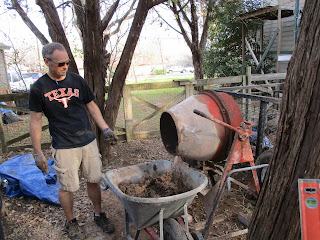T-Brick Shed: Roles & Mud Delivery Logistics
So, I finally tricked someone who doesn't have the same last name as me into coming out and working on the shed. Cassandra is a good friend of ours who shares an interest in natural building. She's such a good a friend and so interested in natural building that she spent all day Saturday with us doing hard labor.
The help was very welcome especially with the wall being around six feet tall now. As the wall gets higher, the logistics of mud delivery becomes more of an issue. When the wall is low you can be pretty efficient with one or two people performing a couple of roles.
The Mixer
The mixer mixes the earth, straw and water into a stiff but workable mixture (Cob). It's a little tricky. Too wet and the blocks slump when you take the forms off. Too dry and the blocks are crumbly. Ideally, you want your finished product to have a sheen to it like worn leather and a deep earthy bouquet. After several tons of practice I've developed a very scientific formula that looks something like this:
Add half of a bucket of water, 10 shovel fulls of soil and 3 hand fulls of straw
Mix well
Add 10 more shovel fulls of soil
Turn the concrete mixer to the horizontal position and let it turn until the mix until consistent
Dump the mixture in a wheel barrow
Repeat
The Packer
The packer takes the cob from the wheel barrow and packs as much into each form as he or she can using a tamper, a brick, a rock or just her mitts. The tricky part of packing is working the cob into the form's corners and making sure the the forms are level and putting the dead men in the correct places. The packer really needs to be above the form she is packing so in the three to five foot range a stool or step ladder When the wall gets higher than that the packer has to stand several rungs up on the step ladder or on scaffolding. This is when third role becomes extremely useful.
The Cob Tosser
The cob tosser stands at ground level with the wheel barrow, forms the cob into a small ball and tosses it up to the packer. A couple of rules for the cob tosser are:
1) Make your cob balls a reasonable size. Tossing a medicine ball for a workout is great. Tossing a medicine ball all day long is crazy.
2) Establish eye contact with your packer before throwing him/her your cob ball. A very important rule, especially if you didn't follow rule number one.
Other useful roles include quality assurance and the floater
Quality Assurance
The Quality Assurance person takes over leveling duties, keeps track of the location of deadmen, arranges the new forms, removes forms from finished blocks and occasionally samples the cob for taste and clarity.
The Floater
The floater runs wheel barrows back and forth, fills up water buckets and helps relieve the other teams.
We had a full complement Saturday and got a lot done. We knocked out the 12th course and finished half of the 13th.

 |
| The Mixer |
The Mixer
The mixer mixes the earth, straw and water into a stiff but workable mixture (Cob). It's a little tricky. Too wet and the blocks slump when you take the forms off. Too dry and the blocks are crumbly. Ideally, you want your finished product to have a sheen to it like worn leather and a deep earthy bouquet. After several tons of practice I've developed a very scientific formula that looks something like this:
Add half of a bucket of water, 10 shovel fulls of soil and 3 hand fulls of straw
Mix well
Add 10 more shovel fulls of soil
Turn the concrete mixer to the horizontal position and let it turn until the mix until consistent
Dump the mixture in a wheel barrow
Repeat
The Packer
 |
| Cassandra packs while my Mom hands up cob balls |
The Cob Tosser
The cob tosser stands at ground level with the wheel barrow, forms the cob into a small ball and tosses it up to the packer. A couple of rules for the cob tosser are:
1) Make your cob balls a reasonable size. Tossing a medicine ball for a workout is great. Tossing a medicine ball all day long is crazy.
2) Establish eye contact with your packer before throwing him/her your cob ball. A very important rule, especially if you didn't follow rule number one.
 |
| Jean lays out forms |
Other useful roles include quality assurance and the floater
Quality Assurance
The Quality Assurance person takes over leveling duties, keeps track of the location of deadmen, arranges the new forms, removes forms from finished blocks and occasionally samples the cob for taste and clarity.
The Floater
The floater runs wheel barrows back and forth, fills up water buckets and helps relieve the other teams.
We had a full complement Saturday and got a lot done. We knocked out the 12th course and finished half of the 13th.
 |
| Eye contact is important |
 |




Comments